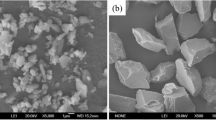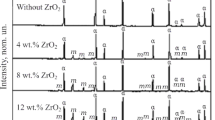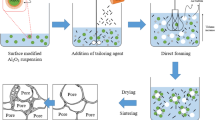Abstract
Porous Al2O3 ceramics were fabricated using a rapid gelation to fix the foam structure after mechanical foaming. The slurry was made with deionized water, Al2O3 powder, a water-soluble copolymer of isobutylene and maleic anhydride, and a surfactant. The resultant gel formed at room temperature in air. The influence of the surfactant (EMAL TD) content on gelling behavior, pore structure (porosity, cell size), shrinkage behavior, and compressive strength of the resultant porous Al2O3 ceramics was evaluated. Porous Al2O3 ceramics were sintered in only one step without debinding because of the low concentration of additives (≤0.5 wt%). The porous Al2O3 ceramics had porosities from 20 to 89% and cell sizes from 60 to 220 μm. The compressive strength was 75 MPa when the porosity was 60%.









Similar content being viewed by others
References
J.K. Park, J.S. Lee, and S.I. Lee: Preparation of porous cordierite using gelcasting method and its feasibility as a filter. J. Porous Mater. 9(3), 203–210 (2002).
J. Saggio-Woyansky, C.E. Scott, and W.P. Minnear: Processing of porous ceramics. Am. Ceram. Soc. Bull. 71(11), 1674–1682 (1992).
H. Kim, S. Lee, Y. Han, and J.K. Park: Preparation of dip-coated TiO2 photocatalyst on ceramic foam pellets. J. Mater. Sci. 41(18), 6150–6153 (2006).
S. Furuta, H. Katsuki, and S. Komarneni: Modification of porous silica with activated carbon and its application for fixation of yeasts. J. Porous Mater. 8(1), 43–48 (2001).
L. Montanaro, Y. Jorand, G. Fantozzi, and A. Negro: Ceramic foams by powder processing. J. Eur. Ceram. Soc. 18(9), 1339–1350 (1998).
P. Sepulveda, F.S. Ortega, M.D.M. Innocentini, and V.C. Pandolfelli: Properties of highly porous hydroxyapatite obtained by the gelcasting of foams. J. Am. Ceram. Soc. 83(12), 3021–3024 (2000).
K.A. Hing: Bioceramic bone graft substitutes: Influence of porosity and chemistry. Int. J. Appl. Ceram. Technol. 2(3), 184–199 (2005).
X. Zhu, D. Jiang, and S. Tan: The control of slurry rheology in the processing of reticulated porous ceramics. Mater. Res. Bull. 37(3), 541–553 (2002).
Y.S. Kwon, G. Son, J. Suh, and K.T. Kim: Densification and grain-growth of porous alumina compacts. J. Am. Ceram. Soc. 77(12), 3137–3141 (1994).
S. Geis, J. Fricke, and P. Löbmann: Electrical properties of PZT aerogels. J. Euro. Ceram. Soc. 22(7), 1155–1161 (2002).
P. Sepulveda: Gelcasting foams for porous ceramics. Am. Ceram. Soc. Bull. 76(10), 61–65 (1997).
P. Sepulveda and J.G.P. Binner: Processing of cellular ceramics by foaming and in situ polymerisation of organic monomers. J. Eur. Ceram. Soc. 19(12), 2057–2066 (1999).
O.O. Omatete, M.A. Janney, and R.A. Strehlow: Gelcasting–a new ceramic forming process. Am. Ceram. Soc. Bull. 70(10), 1641–1649 (1991).
M. Takeshita and S. Kurita: Development of self-hardening slip casting. J. Eur. Ceram. Soc. 17, 415–419 (1997).
X.J. Mao, S.Z. Shimai, M.J. Dong, and S.W. Wang: Gelcasting of alumina using epoxy resin as a gelling agent. J. Am. Ceram. Soc. 90(3), 986–988 (2007).
H.X. Peng, Z. Fan, J.R.G. Evans, and J.J.C. Busfield: Microstructure of ceramic foams. J. Eur. Ceram. Soc. 20(7), 807–813 (2000).
Y. Yang, S.Z. Shimai, and S.W. Wang: Room temperature gelcasting of alumina with a water-soluble co-polymer. J. Mater. Res. doi: 10.1557/jmr.2013.132.
U.T. Gonzenbach, A.R. Studart, E. Tervoort, and L.J. Gauckler: Ultrastable particle-stabilized foams. Angew. Chem. Int. Ed. 45, 3526–3530 (2006).
K. Prabhakaran, A. Melkeri, N.M. Gokhale, and S.C. Sharma: Preparation of macroporous alumina ceramics using wheat particles as gelling and pore forming agent. Ceram. Int. 33(1), 77–81 (2007).
R. Brezny and D.J. Green: The effect of cell size on the mechanical behavior of cellular materials. Acta Metall. Mater. 38, 2517–2526 (1990).
Acknowledgments
The authors would like to thank Kuraray Co. Ltd. and Kao Co. Ltd. of Japan for donating organic materials.
Author information
Authors and Affiliations
Corresponding author
Rights and permissions
About this article
Cite this article
Yang, Y., Shimai, S., Sun, Y. et al. Fabrication of porous Al2O3 ceramics by rapid gelation and mechanical foaming. Journal of Materials Research 28, 2012–2016 (2013). https://doi.org/10.1557/jmr.2013.170
Received:
Accepted:
Published:
Issue Date:
DOI: https://doi.org/10.1557/jmr.2013.170




